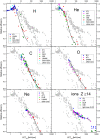MICRODOSIMETRIC UNDERSTANDING OF DOSE RESPONSE AND RELATIVE EFFICIENCY OF THERMOLUMINESCENCE DETECTORS
- PMID: 33418564
- PMCID: PMC7840113
- DOI: 10.1093/rpd/ncaa211
MICRODOSIMETRIC UNDERSTANDING OF DOSE RESPONSE AND RELATIVE EFFICIENCY OF THERMOLUMINESCENCE DETECTORS
Abstract
LiF:Mg,Ti detectors show relative efficiency η for heavy charged particles significantly lower than one. It was for a long time not recognised that η varies also for electron energies and, as a consequence for photons. For LiF:Mg,Cu,P detectors measured photon energy response was named 'anomalous' because it differed significantly from the ratio of photon absorption coefficients. The decrease of η was explained as a microdosimetric effect due to local saturation of trapping centres around the electron track. For TLD-100 it was noticed by Horowitz that the measured photon energy response disagrees with the ratio of absorption coefficient by about 10%. It was demonstrated that a fraction of the TL signal in LiF:Mg,Ti is generated in the supralinear dose-response range, due to the high local doses generated by photon-induced tracks. Prediction of TL efficiency is particularly important in space dosimetry and in dosimetry of therapeutic beams like protons or carbon ions.
© The Author(s) 2021. Published by Oxford University Press.
Figures










References
-
- Horowitz Y. S. Thermoluminescence and Thermoluminescent Dosimetry. ( Boca Raton, FL, USA: CRC Press; ) (1984).
-
- Attix F. H. Introduction to Radiological Physics and Radiation Dosimetry. ( New York: John Wiley & Sons; ) (1986).
-
- Nakajima T., Murayama Y., Matsuzawa T. and Koyano A. Development of a highly sensitive LiF thermoluminescence dosimeter and its applications. Nucl. Instr. Meth. 157, 155–162 (1978).
-
- Olko P., Bilski P., Ryba E. and Niewiadomski T. Microdosimetric interpretation of the anomalous photon energy response of ultra sensitive LiF:Mg,Cu,P TL Dosemeters. Radiat. Prot. Dosim. 47, 31–35 (1993).
-
- Olko P. The microdosimetric one-hit detector model for calculating the response of solid state detectores. Radiat. Meas. 35, 255–267 (2002). - PubMed

